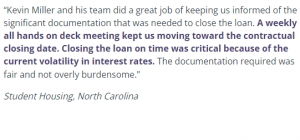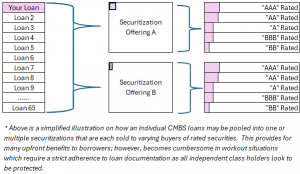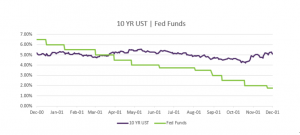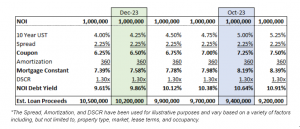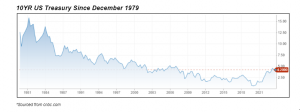Blog
Where Does Commercial Real Estate Fit in an Investment Portfolio?

Commercial real estate (CRE) may offer owners a powerful way to protect and grow their wealth. Depending on strategy, CRE can act either as the cornerstone or as a diversifier within an asset allocation, so should be considered when investors and wealth managers are building an investment portfolio.
CRE differs greatly from other investment assets, such as stocks, bonds and other securities, in both the acquisition process and management of the asset. It is these nuances that many investors see as a hindrance to entering the commercial real estate market, but the advantages of CRE in a portfolio can compensate for the complications. Here is how CRE fits into a portfolio of investment assets:
Diversification
Managing risk is key to any investment portfolio. Commercial real estate offers moderate risk for long-term potential returns. According to NCREIF (see chart, below) commercial properties have delivered an average return of 9.57% per year from 1978 to 2016, just under 4% less than the average return over the same period from the S&P 500. However, CRE’s volatility (7.62%) is 8.84% less than the S&P 500 (16.46%). Ultimately, the returns from CRE tend to be more than bonds and less than stocks, but the risk also falls in the middle of both asset classes.
| S&P 500 | NCREIF Property Index | |
|---|---|---|
| Avg. Returns per year | 13.52% | 9.57% |
| Volatility | 16.46% | 7.62% |
Source: NCREIF. The NCREIF Property Index represents returns to a direct, unlevered investment in a diversified portfolio of U.S. commercial property.
In addition, commercial real estate has historically had a low correlation with other asset classes, making CRE a useful diversifier in an investment portfolio (see table below).
| MSCI World | 10-Year US Government Bonds | Global REITS/Real Estate Equities | Direct Investment in Office Real Estate Global | |
|---|---|---|---|---|
| MSCI World | 1 | -0.6 | 0.8 | 0.3 |
| 10-Year US Government Bonds | - | 1 | -0.34 | -0.15 |
| Global REITS/Real Estate Equities | - | - | 1 | 0.35 |
| Direct Investment in Office Real Estate Global | - | - | - | 1 |
Correlation of price changes (all indices in local currency). Source: PMA, Datastream, Credit Suisse. Calculated on the basis of price indices for quarterly figures, starting from December 31, 2000. Last data point: June 2014.
Tangible asset
A mix of tangible and intangible financial assets can enhance an investment portfolio. While intangible assets like stocks and bonds are subject to market volatility, the value of the brick-and-mortar building, is driven primarily by economic fundamentals.
The drawback of this tangible asset is that commercial buildings require upkeep and management. However, managing and improving commercial buildings in areas like energy efficiency or accessibility can raise their value.
Steady cash flow
Rent from CRE can produce dependable, steady cash flow and liquidity for the owner, an important consideration for any portfolio. Commercial buildings with long-term leases, in particular, can deliver consistent monthly cash flow.
These properties also have the advantage of being potentially easier to manage. Retail properties with established chains or franchises, as well as office and industrial properties with long-term occupants, don’t have a high turnover of tenants, meaning they can become a higher yield, lower maintenance investment for owners.
Inflation protector
CRE can be an effective way to protect against inflation. As inflation rises, and the prices for goods and services increases, CRE owners for certain commercial properties can often adjust their rental rates upwards.
With hotels, prices can be reviewed on a daily basis in response to demand and competition. Other properties, such as multifamily buildings or self-storage units (where short-term leases and agreements are usually in place), can adjust for inflation on a monthly or annual basis, depending on the lease. While this does require more management than a long-term lease, it is more responsive to price changes.
Commercial Real Estate in Your Investment Portfolio
CRE should be a consideration for investors when developing an investment portfolio. While it may not be an ideal fit for some, it can be an important asset for others.
Are you looking to refinance a commercial property or considering adding CRE to your investment portfolio? Contact Plum today to learn about your loan options, including access to long-term financing.
Related
A quick, smooth loan closing begins before you reach out to a lender. It’s made possible by understanding the type of documentation lenders look for, and when, and in which format, they need to receive it. The type of property being financed will influence key documents; however, the following are items that are consistent across…
Read More >>CMBS loans have become popular in 2024 as regional and local banks have slowed or halted new loan production. For those that aren’t as familiar with the CMBS product, the loans are heavily structured and largely originated by lenders with little to no customer relationship. The loans are quickly sliced, diced, pooled and converted into…
Read More >>While the Fed is an important driver in the economy, it isn’t the only factor that shapes long-term interest rates for commercial real estate. We saw interest rates move independently of the Fed’s actions in the year 2000. At that time, the Fed had abandoned their two year fight against inflation and turned on its…
Read More >>Santa came early for some commercial real estate owners who locked a rate in the past week. The 10YR US Treasury yields dipped then rallied last week, declining to 4.11% before bouncing back to current levels near 4.25%. Is this dip and then increase back to the prior week’s levels a sign of a…
Read More >>CRE Owners Catch a Break This past week, commercial real estate owners caught a huge break. The 10YR treasury yields fell almost 0.30% throughout the week, and are 0.80% lower than their high of ~5.00% in mid October. Not even Friday’s comments by Fed Chair Powell that “rate cuts are premature” stopped yields from…
Read More >>COMPANY
© 2019 PLUM Lending. All Rights Reserved. | Terms of Service | Privacy | Plum, Inc. dba Plum and/or Plum Lending

